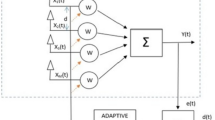Abstract
This paper proposes an efficient bit-loading algorithm for Multiple-Input-Multiple-Output transmission over spatially correlated channels with perfect Channel State Information at both link ends. Based on water-filling principle, the algorithm does not assume the well-known gap approximation and accounts for the spatial correlation effects through the initial bit allocation. The result is the optimal distribution of bits and power over the eigenmodes for multiple antenna systems. We report the performance evaluations in the presence of spatial correlation in order to illustrate the efficiency and the robustness of our bit-loading algorithm in realistic environments. The simulation results demonstrate that our algorithm leads to significant improvements. In addition, these results show that our algorithm achieves the maximal diversity order, as well as exhibiting a high extra coding gain.












Similar content being viewed by others
References
Telatar, E. (1995). Capacity of multi-antenna Gaussian channels. AT &T Bell Laboratories, Technical Memorandum.
Foschini, G. J. (1996). Layered space-time architecture for wireless communication in fading environment when using multi-element antennes. Bell Labs Technical Journal, 1(2), 41–59.
Foschini, G. J., & Gans, M. J. (1998). On limits of wireless communications in a fading environment when using multiple antennas. Wireless Personal Communications, 6(3), 311–335.
Nguyen, H., & Andersen, J. (2006). On the performance of link adaptation techniques in MIMO systems. Wireless Personal Communications, 42(2), 543–561.
Zhou, Z. D., Vucetic, B., Dohler, M., & Li, Y. (2005). MIMO systems with adaptive modulation. IEEE Transactions on Vehicular Technology, 54(5), 1828–1842.
Shiu, D. S., Foschini, G. J., Gans, M. J., & Kahn, J. M. (2000). Fading correlation and its effect on the capacity of multielement antenna systems. IEEE Transactions on Communication Magazine, 48(3), 502–513.
Forenza, A., & Heath, R. W. (2004). Impact of antenna geometry on MIMO communication in indoor clustered channels. In Proceedings of IEEE antennas and propagation system (pp. 1700–1703).
Sampath, H., Stoica, P., & Paulraj, A. J. (2001). Generalized linear precoder and decoder design for MIMO channels using the weighted MMSE criterion. IEEE Transactions on Communication, 49(12), 2198–2206.
Collin, L., Berder, O., Rostaing, P., & Burel, G. (2004). Optimal minimum distance-based precoder for MIMO spatial multiplexing systems. IEEE Transactions on Signal Processing, 52(3), 617–627.
Kim, Y., Lee, H., Park, S., & Lee, I. (2008). Optimal precoding for orthogonalized spatial multiplexing in closed-loop MIMO systems. IEEE Journal on Selected Areas in Communication, 28(8), 1556–1566.
Getu, B. N., & Andersen, J. B. (2004). MIMO systems in random uncorrelated, correlated and deterministic radio channels. Wireless Personal Communications: An International Journal, 30(1), 27–61.
Wyglinski, A. M., Labeau, F., & Kabal, P. (2004). An efficeint bit allocation algorithm for multicarrier modulation. In Proceedings of IEEE wireless communications network conference WCNC (pp. 1194–1199).
Wyglinski, A. M., Labeau, F., & Kabal, P. (2005). Bit loading with BER-constraint for multicarrier systems. IEEE Transactions on Wireless Communication, 4(4), 1383–1387.
Chung, S. T., & Goldsmith, A. (2001). Degrees of freedom in adaptive modulation: A unifed view. IEEE Transactions on Communications, 49(9), 1561–1571.
Campello, J. (1998). Optimal discrete bit loading for multicarrier modulation systems. In Proceedings of international symposium of information theory (pp. 193–193).
Hughes-Hartogs, D. Ensemble modem structure for imperfect transmission media. U.S. patents no 4,679,227, July 1987, 4,731,816, March 1988, and 4,833,706, May 1989.
Sonalkar, V. R., & Shively, R. (2000). An efficient bit-loading algorithm for DMT applications. IEEE Communications Letters, 4(3), 80–82.
Chow, P., Cioffi, J., & Bingham, J. (1995). A practical discrete multitone transceiver loading algorithm for data transmission over spectrally shaped channels. IEEE Transactions on Communication, 43(234), 773–775.
Shiu, D. S., Foschini, G., Gans, M., & Kahn, J. (2000). Fading correlation and its effect on the capacity of multielement antenna systems. IEEE Transactions on Communication, 48(3), 502–513.
Bergman, S., Palomar, D., & Ottersten, B. (2009). Joint bit allocation and precoding for MIMO systems with decision feedback detection. IEEE Transactions on Signal Processing, 57(11), 4509–4521.
Proakis, J. G. (1995). Digital communications (3rd ed.). New York: McGrawHill.
Papandreou, N., & Antonakopoulos, T. (2005). Dynamic bit-loading in pDSL communications systems. In IEEE international symposium on power lines communication (ISPLC) (pp. 356–360).
Andersen, J. (2000). Array gain and capacity for known random channels with multiple element arrays at both ends. IEEE Journal on Selected Areas in Communication, 18(11), 2172–2178.
Acknowledgments
This research was supported by the CISIT project. The authors would like to thank the Nord/Pas-de-Calais Region for financial support.
Conflict of interest
The authors declare that they have no competing interests.
Author information
Authors and Affiliations
Corresponding author
Rights and permissions
About this article
Cite this article
Fatani, I., Zwingelstein-Colin, M., Gharbi, M. et al. An SVD-Aided Efficient Bit-Loading Algorithm for MIMO Transmission Over Spatially Correlated Channels. Wireless Pers Commun 75, 1167–1185 (2014). https://doi.org/10.1007/s11277-013-1414-3
Published:
Issue Date:
DOI: https://doi.org/10.1007/s11277-013-1414-3




